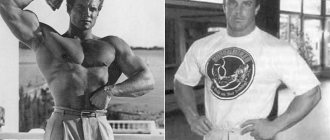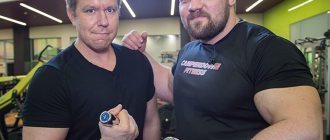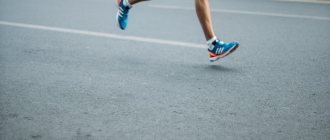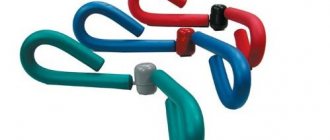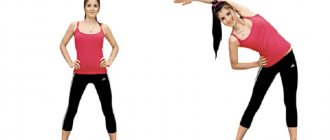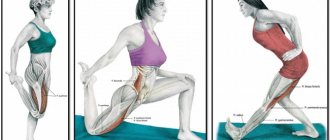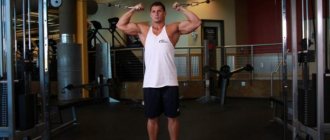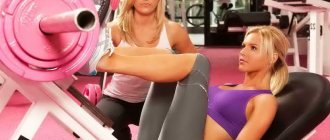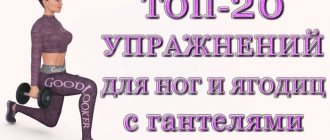| ATHLETE.RU :: Forum :: Books | Settings |
Return to contents Next chapter >>>
Main working muscles
:
Erector spinae, obliques, abdominal muscles.
Short description:
Holding the weight at your hip, lean sideways in the same direction and stand up straight again.
Preparation and starting position
Place your feet approximately hip-width apart. However, use this recommendation as a general guideline only. If you frequently experience groin strains, you may want to place your feet together. But keep in mind - the narrower your legs are, the more difficult it is to maintain balance. And one more thing - if you have an easily injured groin, try keeping your buttocks tense throughout the entire exercise.
Side bends can be done with a dumbbell or a barbell. However, plates on a traditional barbell make it difficult to maintain a smooth trajectory of movement - at least if you do the exercise while standing. The dumbbell needs to be held slightly to the side of the hip - otherwise the weights will touch your leg. With a barbell, you can keep your hand directly at your hip. You can even use an Olympic bar - although the shorter the bar, the easier it is to keep the bar balanced. If you hold the barbell correctly and perform your reps with skill and control, you can even balance an Olympic bar. To maintain balance, the bar should be kept strictly horizontal and the movements should be made very technically. If the bar is long enough, then it is better to do side bends with a barbell in a power rack. Set the restraints 2 cm above the lowest point to which you can bend sideways. Limiters perform three important functions here. Firstly, they will not allow you to make movements with an excessively large amplitude. Second, they allow you to briefly rest the bar on them between reps if necessary. This allows you to release your grip for a few seconds without removing your hands from the bar. This way, your hand and forearm muscles will get a little rest before the next repetition. Third, the limiters will catch the bar if you lose control of it. Before you do the first rep of a barbell set, make sure you grip the bar in such a way that it doesn't tip to one side when you lift it off the bars. If the bar leans in one direction at the very beginning of the set, then put it in place and don’t wait until it starts to tilt even more. Otherwise you will have to end the set prematurely.
Left: Side bends in a power rack. In the center: side bends with a dumbbell. Right: seated side bends.
Side bends while standing can be performed with good technique while standing with a dumbbell, if its plates do not touch your legs and the dumbbell is collapsible. Try to put the weights on the very end of the dumbbell bar so that when performing the exercise you can move the bar as close to your thigh as possible without touching your legs with the weights. To do this, you can insert some kind of spacer piece on the dumbbell bar between the weights and the handle. Thus, the weights will be placed on the dumbbell bar closer to its ends. However, if the dumbbell bar is short, then you may not have enough space on it to secure the plates with locks.
The weights on the Olympic bar and, especially, on the dumbbell must be secured with locks. If the plates move just a little, the balance of the bar will be disrupted. Locks will not allow this to happen.
The easiest way to do side bends with dumbbells is while sitting. This exercise is done while sitting on the edge of a bench, in the middle of a bench, or sitting on a box. Spread your feet wider to maintain balance. Seated side bends are a very good exercise if performed with the technique recommended here. You will not have problems due to the fact that the weights cling to your legs and prevent you from moving the weight through the desired amplitude. Still, be careful not to lean too far to the side.
Performance
Take the weight in your right hand. Place your free hand (left) on the oblique abdominal muscles on the left to “feel” how these muscles will work. Lean to the right - as far as possible without feeling discomfort. Then return to a vertical position. Do all repetitions, always leaning to the right, without interruption. Then take the weight in your other hand and work the opposite side of your body. While performing a set, do not turn your head to the sides or tilt down - look straight ahead.
Movement should only occur sideways. Don't lean forward, don't lean back, or try to move in an unnaturally large amplitude.
Do not put too much load on the leg that is on the side of the weight - otherwise, you risk losing your balance and falling to that side.
Do the repetitions carefully - the upward movement should last about two seconds, the downward movement the same. Or, you can do the exercise even slower—4 seconds up, 4 seconds down—and reduce the number of reps per set. Don't do the exercise hastily. It is very important that the movement is smooth and that you control its negative phase even after the last repetition, when you want to put the weight on as quickly as possible. When going down, inhale, when going up, exhale.
After an intense set of bending to one side, rest for a couple of minutes before moving on to bending to the other side. This will help you take a breath, gain strength and do a better set.
If in one workout you do the first set of bends, for example, to the right side, then in another workout, on the contrary, do the first set of bends to the left.
What are the benefits of bending?
Among the advantages of this effective exercise it is worth highlighting:
- improving spinal flexibility;
- improving the mobility of the hip joints, which allows you to avoid many unpleasant moments associated with health.
- training the hamstrings;
- training the muscles of the back, abs and buttocks;
- improved blood circulation;
- reducing the development of vascular diseases of the head.
As you can see, the benefits of such an exercise, which we were familiar with in childhood, are quite great.
Other tips
You should get used to the exercise carefully and gradually - especially if you have never done it before or have not done it for a long time. In this case, do the exercise twice a week without weights for two weeks. Do a couple of sets of high reps. Keep your hands first at your sides, then, as your strength increases, behind your head. Focus on doing the movement technically, without jerking. Bend down to a level that does not cause you discomfort. If your flexibility improves, you will be able to slightly increase your range of motion after two weeks. Do not try to bend lower by leaning forward.
To learn the trajectory of movement, do the exercise while standing sideways to the mirror. Turn your head to the mirror and track your technique - bring it to perfection. But when working with serious weights, do not turn your head. During intense lateral bending, you should always keep your head straight.
Starting in the third week, take light weights and then slowly and gradually increase the weight with small additions.
As long as the exercise is easy for you, it doesn’t matter where it is in your program. But as soon as your weights grow in it and require intense effort from you, avoid bending to the sides before basic exercises. Either do them after the basic exercises, or on another day.
Before starting an intense set, you should warm up thoroughly - first without weight, then with light weight.
When you get to heavy weights, put chalk on your palms and do each set almost to failure. Just like in the deadlift (both on straight and bent legs), you should not do that very last “killer” repetition. Do-or-die work in lateral bending is not suitable, because... You may get injured.
In addition to being a valuable tool for developing the core stabilizing muscles, side bends add variety to your core movement routine. However, although side bends are a "minor" exercise, they can be very intense if you really take them seriously.
Side bends should be done with particular caution by people who have had lower back problems in the past. If bending to the sides leads to back pain, then do not persist. It’s better to try an alternative exercise to bending to the sides. This exercise, for the sake of variety, can also be inserted into their cycles from time to time, even by those athletes who can safely perform regular side bends. But even this alternative exercise requires a healthy lower back. Also do it with caution.
Latissimus dorsi: how to relieve tension in the scapular region
The latissimus dorsi muscles are so named because they occupy a large area on the surface of the human body. The shape of the muscle fibers resembles an inverted triangle, covering part of the scapular and lumbosacral region, as well as the attachment point of the shoulder joint.
This muscle complex is responsible for:
- extension and internal rotation of the arms in the shoulder joints;
- ghost of the upper limbs.
Why does pain occur?
Since the latissimus dorsi muscles occupy almost the entire space of the torso, when tense, they are able to capture the nerve endings of neighboring muscles. In addition, they can form so-called “trigger points”.
“Trigger points” are areas of greatest tension in muscle tissue. To eliminate such clamps, it is necessary to conduct a thorough search for them. When you feel the affected area, you can feel a very tight tension, and when palpating, you can feel severe pain.
Most often, when the latissimus muscles are overloaded, painful sensations occur in:
- shoulder joint attachment zone (front);
- areas of the lower angle of the scapula;
- shoulder and armpit;
- iliac region.
How to understand that pain is caused by the latissimus dorsi muscles
To understand the problem, it is necessary to carry out several test movements.
- You need to raise your hand, place it behind your head and reach your mouth or its corners with your palms. The affected areas of the latissimus muscles will not allow you to do this at full strength.
- Try to reach the base of the shoulder blade with the brush. If the cause of the pain is the tightening of the muscles covering the back, then the hand will linger below the required test area (approximately below the shoulder blades or even on the lower back).
- Stretch your arm up on the side where the pain is felt, try to bring it to your ear. The latissimus dorsi muscles will interfere with a calm reduction.
Relaxation exercises
The latissimus dorsi muscles are responsible for the position of the torso and pelvis in space, bending the spine forward and to the sides. Excessive tension causes them to shorten, and, consequently, the spine begins to deviate from its axis. Not only the back suffers, but also the internal organs.
Fortunately, there are special sets of exercises that help relax the torso frame. They need to be done regularly, since “trigger points” take more than one day to form.
- It is necessary to raise your arm bent at the elbow (on the side where the pain is felt) and try to move it behind your head as far as possible. The movement can be done using the second hand. You need to stay in this pose for a few minutes. At first there may be discomfort, but after a while relaxation will occur. At the moment of abduction of the arm, you can take a deep breath. This will help stretch the muscles in the tight area as much as possible.
- Stand straight, feet shoulder-width apart. You should raise your hand up smoothly, carefully bending in the opposite direction. When performing such exercises, you can feel a pleasant sensation of weight, which helps smooth out the muscles at “trigger points”. It is not advisable to bend your knees.
- Side crunch exercise. You need to sit down, bend your leg at the knee and bring it behind the other leg, which remains extended. The bent knee must be grasped with the opposite hand. Next, side twists are performed. The chest should be kept flat while taking deep breaths and exhalations. It is recommended to change the position of the arms and legs, as this helps to better work the latissimus muscles and ensure balance on both sides of the body.
- Another exercise to stretch the back muscles. You need to sit down with your legs stretched forward, with an even posture. Next, you need to try to stretch the crown of your head as high as possible. This option is very effective and helps to feel the nerve bundles that cause pain in the shoulder blades.
- Stretch your legs and clasp your toes with your hands. The more you bend your body, the better. Performing such a movement is difficult in the initial stages. But by staying in this position for several minutes, the muscles relax and the exercise becomes easier.
A back massage also helps to work out trigger points. You can do it yourself using special massage rollers and rollers. A regular tennis ball will also work. You need to squeeze it between the point of tension in your back and the wall and roll it along a hard surface. These movements can be done while lying down.
Daily gymnastics will not only relieve tension, but also form a special motor pattern, which in the future will help to avoid the re-formation of muscle lumps.
How to prevent overvoltage
Nerve bundles formed when the latissimus muscles are overloaded cause severe discomfort and interfere with performing simple everyday tasks.
To prevent clamps in the torso, you must:
- monitor the strength, frequency and balance of loads. With monotonous movements (pull-ups on parallel bars, painting walls), the risk of disease is high.
The disease is also possible in athletes who use this muscle group to the maximum (climbers, swimmers).
- Static loads, such as working at a computer, can also cause tightness and shortening of the latissimus muscles, so you need to do a set of exercises aimed at relaxing the “trigger points.”
The problem of pinching the latissimus dorsi muscles is not so obvious at first, but over time the symptoms become more and more common. This happens due to the formation of habitual areas of tension in nerve bundles.
That is why, at the slightest suspicion of the formation of “trigger points,” it is necessary to begin performing special exercises selected by competent specialists.
The load should be limited if possible. Author: K.M.N., Academician of the Russian Academy of Medical Sciences M.A. Bobyr
